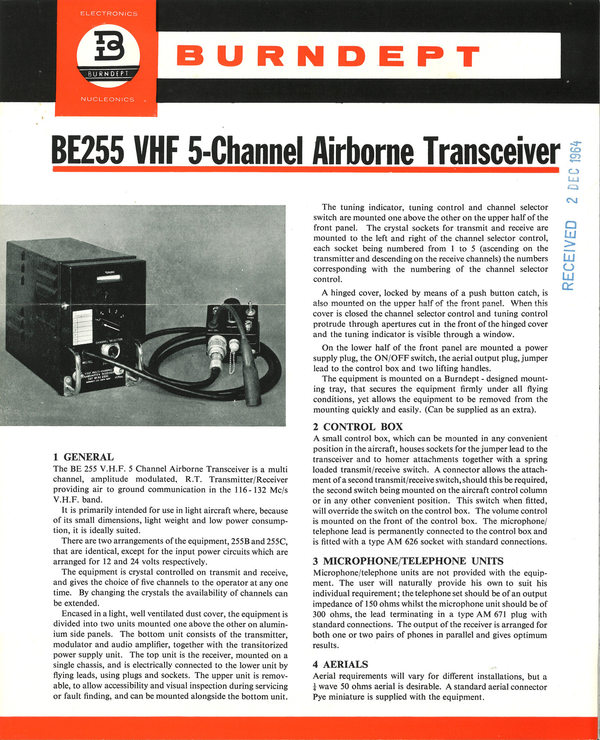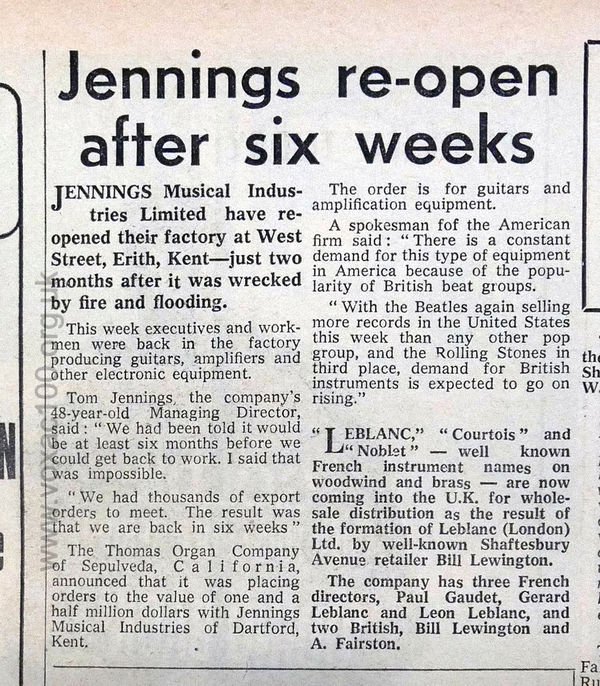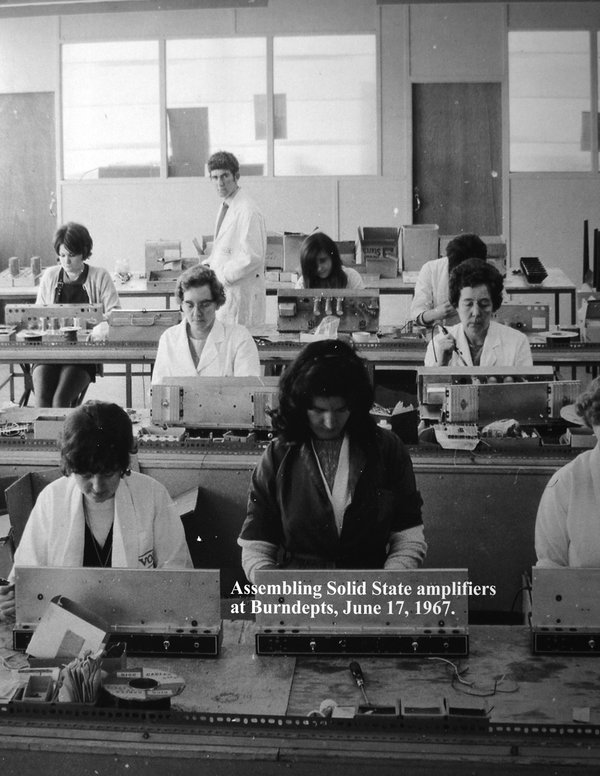The Burndept Electronics / Vox Works at Erith (Kent)
The "West Street Works"
Late 1964 to 1968
Detail of the Vox / Burndept Factory. This is where the majority of AC100s were manufactured - from around serial no. 300 - 2200. Behind it stands the "Elizabethan Electronics" building. See the maps further down this page.
For Westrex, which made AC80/100 chassis from late 1963 to early 1965, see this page.
Burndept Electronics - background
Burndept Electronics began life in the early 1920s as a wireless and speaker manufacturer based in Blackheath, south-west London. In 1934 the company was bought out and amalgamated with Vidor, a maker of batteries, and a brand that survived well into the 1970s. A year later, in 1935, the manufacturing branch of Burndept moved away from London to Erith in Kent, leaving the aerial side of operations in Blackheath. The company's new Erith premises was the old "Light Gun Factory", once part of the Royal Ordnance. During the war Burndept produced military communication systems and cookers, of all things. The factory was bombed out, though, in 1941.
Early Burndept brochures; the advertising van; a speaker horn
Left, the exterior of the Light Gun Factory before 1941 (from Jim Elyea, Vox Amplifiers, p. 35); right, the interior of the assembly hall.
By the late 1950s, Burndept appears to have acquired at least three sites in Erith: one on St Fidelis Road (postcode DA8 1AU); another on West Street (postcode unknown); and a large building on the river side of Erith High Street (just before the High Street becomes West Street) - the "Riverside Works" (postcode DA8 1QY).
The Burndept Riverside facility in the early 1960s; the Riverside Swimming Pool, designed by Richard Seifert in 1968, with the dilapidated Riverside Works in the background. The Seifert building, which stood on the left hand side of the road (and still does in Google Street view), has recently been demolished.
In the early 1960s Burndept's output was principally aviation communication and tracking systems (aids for air-sea rescue, produced at the Riverside Works), along with a range of domestic electrical equipment and components. In the later 1960s the company made transmitters and receivers for Pye and the Home Office. A good selection of these are pictured on this thread and on this.
A receiver unit made by Burndept for the Home Office.
In 1961 the business was taken over by Royston Industries, the company that by January 1963 (not September as is sometimes said) had acquired a controlling interest in Vox/JMI from Tom Jennings: and it was Royston's decision to fund Burndept's unsuccessful "Midas" black box flight recorder, a project that brought the shaky edifice created by Royston tumbling down in late 1967. Profits made by the other companies in the Group had systematically been drained off into the development of the "Midas". Even in 1964, the wisdom of chasing flight recorder business had been questioned in the financial press. But Royston took no notice. The official receiver was appointed in December 1967. Jennings went on for a few months thereafter, ceasing trading in Spring 1968; a number of divisions of Burndept survived into the early 1980s.
VOX
As Jim Elyea has indicated, relations with Burndept went back some way before the Royston deal. Not only did Jennings have the chassis for his combo-organs made up at Erith in the late 50s; but the manufacture and assembly of runs of amplifier chassis - notably AC30s - had been contracted out to the company by late summer 1962. Burndept-made units are readily distinguishable by machine-stamped serial numbers on the aluminium of the preamp upright - below the voltage selector in the case of AC30s made from 1962-1966; and above the output terminal block in the AC80/100s and AC100s that Burndept produced from 1965.
With orders pouring in in 1964, JMI forumulated plans for expansion: a new factory at Dartford Road, two in Erith, and a new London showroom. As it turned out, only two of the four buildings came about: 117 Dartford Road was redeveloped; and in late 1964, JMI moved certain operations to a single factory in Erith - the West Street Works:
"Record Retailer and Music Industry News", 30th April, 1964
A report - 3rd November 1964 - of the readiness of the West Street Works in Erith: "completion" refers simply to the refitting of the building. Production of amplifiers began shortly thereafter: AC50s first, then in early Spring 1965, AC100s.
A large proportion of the manufacturing previously undertaken by Westrex and at Dartford Road was relocated there. On the top floor was the Research and Development Dept., along with part of the Organ Dept., and general storage areas - packing materials, items waiting to go out. Amplifier production took place on the First Floor; Despatch was on the Ground Floor. Some parts of the building were retained by Burndept.
On 23rd July 1965 "The Kentish Times" printed an extract from the Royston Industries Annual General Meeting which stated: "This company [Jennings Musical Industries] has been operating from several locations but has now largely been moved to a new factory at Erith, thus saving overheads and ensuring greater efficiency". However, 119 Dartford Road remained, and manufacturing of various items was still contracted out.
The telephone number originally printed - Erith 33080 - is that of the West Street Works. One also finds it in Vox literature from 1965. The fact that the number crossed out in the Burndept flyer (dated 2nd Dec. 1964) probably indicates that the department concerned had moved out to make room for Vox.
Aerial view of Erith in the late 1950s
Detail of the Vox / Burndept Factory. This is where the majority of AC100s were manufactured - from around serial no. 300 - 2200. Behind it stands the "Elizabethan Electronics" building.
Below, details of two maps, one general, the other more detailed, to show the position of the Works:
A broader map - Ordnance Survey 1971, 1:25000 series:
Ordnance Survey TQ5078-TQ5178, 1:10000 series (produced for the National Grid).
On 1 December 1965 fire broke out, destroying the top floor. Fortunately the rest of the factory was saved. This shot was taken from the "railway" side of the building.
The report of the fire in "The Kentish Times", 10th December 1965. Note that there were 70 people at work in the building at the time - "most of them women doing electrical wiring on the second floor". The wiring in question was the wiring of Vox Continentals in the Organ Department.
While the damage to the West Street Street Works was being repaired, JMI moved production to Burndept's Riverside Works (see the picture of the building near the top of this page. Six weeks later, the Erith Works was ready for business again.
Music trade press, 4th February, 1966.
The Vox Factory and Elizabethan Electronics building, a shot probably taken some time after the 1965 fire (not before as previously stated). Image (Ken Chamberlain) from this wonderful blog.
West Street in the 1950s (thanks to Andy for identifying the decade). The slip road to the works - Nordenfeldt Road - is to the left at the warning triangle on the striped pole.
AC30s and AC50s being finished
The week after JMI had been tipped to win the Queen's Award for Industry, mid January 1967, one of the local Dartford newspapers published a double-page spread on the company. Among the pictures printed was a shot of the ground floor of the West Street Works, Erith, reproduced from the negative (though in cropped form) by Jim Elyea in his book on Vox amplifiers - the pic. above.
The paper also gave an overview of the activities that took place on various floors in the Works. Following the fire of December 1965, guitars had been moved back to Dartford Road - but production of the majority of amplifiers and organs, and the finishing of speaker cabinets, remained in Erith, having been moved out only briefly in 1966 to Burndept's Riverside Works so that repairs to the building could be carried out.
In its overview, the paper omitted two things - that amplifiers had been produced on the first floor; and that the top floor, which bore the brunt of the fire's force, was also used for storage.
Published late January 1967.
On the 19th April, the top two floors of the Erith Works officially opened and all manufacturing remaining at 115 Dartford Road (some organs and guitars) moved there, Dartford Road now used only for Dispatch.
The creation of a "Research Laboratory" presumably meant that the rooms set aside for R&D on the upper floors of 117 and 119 Dartford Road were to some extent emptied out. The new amplifier making section was for the new range of solid state amps (Conqueror, Defiant, Supreme, et al.).
A section from a piece in the local Dartford press, 29th April, 1967.
Tom Lee's visit to the West Street Works in April '67, picture published in July 1967. In the background Reg Clark, General Sales Manager.
In June 1967, the music trade press recorded that the Sales, Administration, Accounts, and Publicity Departments had moved across to Erith.
Below, two pictures showing the chassis numbers typical of Burndept-made chassis. Now and again, the stamping went wrong - but instances are comparatively rare (no more than a half dozen known at present).
On the left, AC30 Bass, chassis no. 04767. On the right an AC50 chassis with corrected stamping.
After the demise of JMI in Spring 1968, the West Street works became home to "Vox Sound Equipment Ltd" (until late 1969) and for a short time (early 1970 to summer 1971), "Vox Sound Limited". In the summer of '71 VSL moved to Hastings/St-Leonard's-on-Sea.
On Vox Sound Equipment Limited (VSEL), see this page on the Vox Supreme website. Info about Vox Sound Limited can be found here.
An assembly room on the second floor of the Works. Unfortunately the caption on this picture is wrong. The photo was actually taken in June 1969 - one can tell from details of the Defiants on the assembly tables.
A picture of one the Burndept assembly rooms on the ground floor taken c. 1983. From 1965, Burndept retained most of the ground and first floors of the West Street Works for its own operations.
As far as AC80/100s are concerned, production began with the cathode biased amps at around serial number 300 (chassis number 1001), continuing through to the fixed bias AC100 Mk 2s, ending in late 1967. The cathode biased amps made at West Street are also distinguishable by the presence of an upright choke, white Erie resistors, and systematic use of the dome voltage selector. Effectively, the Burndept chassis was new, lacking the large cut-out for the Woden laydown choke. For examples of Westrex-made and Burndept-made AC80/100s, see this page.
On the left, a Westrex-made grey-panelled cathode biased amp from the first or second quarter of 1965, serial number unknown (probably somewhere in the low 300s). Note the large cut-out for the Woden laydown choke. The second image is of a Burndept-made cathode-biased amp with a stand-up choke, serial number again unknown, but chassis no. 1055. Images three and four are of serial no. 502, chassis no. 1209 - fixed bias.
It is likely that the new location of the Dispatch Dept. made little difference to Westrex and Triumph Electronics (a second contractor employed by Vox). Finished chassis were simply sent there rather than to Dartford Road.



































